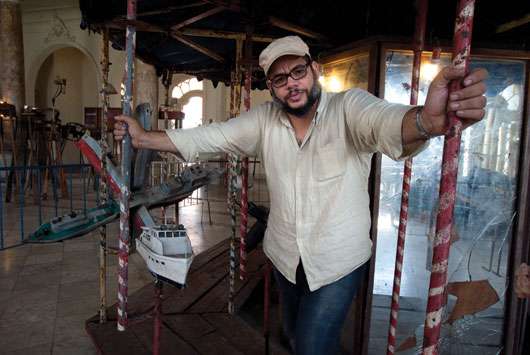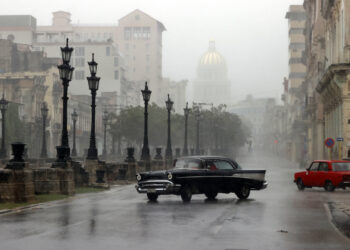Photos: Alain L. Gutiérrez
To be born on an island is a determining factor, but living between two seems to have defined the aesthetics (and the ethics) of the artist Kcho —less known by his name, Alexis Leiva Machado. He is a disturbing creator that assures us, and reiterates with total certainty, that the life of Cubans is sketched by the sea: “our island emerges from a rock that comes from the sea, the first plants came by sea, the aboriginals arrived on canoe, the Virgin of Charity appeared in a bay, the slaves also came from Africa on ships, the Granma yacht, immigration… it all has to do with the sea that surrounds us”.
Kcho (Isle of Youth, February 12, 1971) currently lives and works in Havana and has had more than 90 solo exhibits and 200 group shows in 35 countries. His work has succeeded in penetrating the most demanding international contemporary art circuits and similarly has received important prizes, such as the Diploma of Artistic Merit awarded by Cuba’s University of the Arts, Havana, 2001; Résidence Atelier Calder, Saché, France, 1999; Great Prize at the Kwangju, Korea, Biennial, 1995; UNESCO Award for the Promotion of the Arts, Paris, France, 1995, and the Scholarship of the Ludwig Foundation, Ludwig Forum, Germany, 1994, among others.
A prolific, expanisve artist, for some controversial and irreverent and for others impertinently analyzed, the fact is that Kcho does not go unnoticed because both his work and his life are marked by that which he defends with vehemence: “his homeland”. This he made clear in “Sacrifice at the Crossroads”, an exhibit whose purpose was to share in a single line of thought, what he tells, what he feels and what he is as an artist; that is, his concerns and trajectory.
In an exclusive conversation with OnCuba, Kcho said that one of the major achievements of “Sacrifice at the Crossroads” —exhibited in the Cuban capital between February and April of this year and considered the most important one to date in his long and successful career— is that it demonstrates step by step his development as an artist, something that, he emphasized, “provides an aggregate measure of my work”. At the same time, he pointed out that he feels equally at ease doing an installation or a bi-dimensional work because “it all forms part of the thought process”.
It is said that after the great Wifredo Lam, Kcho is the Cuban artist who has best been able to position himself in the international market. And it is true, but for him, “more than selling, the important thing is to understand that the art market is like the sea: changing and, above all, in a period of crisis”. Notwithstanding, he underscored that Lam is great not because he sold or sells at high prices but because culturally speaking, he expresses in his work the essence of Cuban culture and showed this to the word. And Kcho immediately added that from a very young age he was a very visible face: “at just 25, I entered the New York Museum of Modern Art (MoMA) and the only one who was there was Lam with ‘The Jungle’. In every museum of the world where I have shown Lam was already there; in other words, Lam opened the way”.
For Kcho art is a tremendous responsibility and thus he works daily with determination. He considers that his life did not begin the day in which MoMA bought a painting nor did it end when they invited him to exhibit at the Venice Biennial: “one collection, one museum is something else in the career of an artist; the real energy is in life and in creative work, and in the day to day, which is where all my energies emanate from”, he says.
That deep-rooted conviction, that commitment to his work, that inclination toward the theme of migration —inextricably linked to the sea given our insular character and our history— and, above all, that infinite attachment to the place where he was born, which has forced him to divide up between the “small island” and the “big island”, are the reasons that his work smells of salt, but is anchored on land. “The island of my dreams, the Isle of Youth, is the place where I always want to return. There I am not the artist or Parliamentary representative, but simply Martha’s son, and that is a great joy. My mother not only marked me but also many other people and in the Isle she is remembered all the time. I am still Martha’s son and that I will never forget. And I love it!”.




-60-x-50-cm-Impresión-lightjet-sobre-KODAK-Endura-papel-fotográfico_0-120x86.jpg)






Hi there, always i used to check website posts here early in the break of day, since i enjoy to find out more and more.